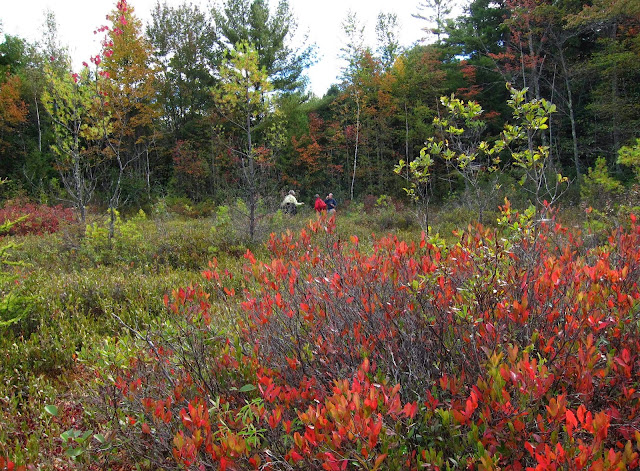Thursday, September 26: The morning mist still lay thick along the Schroon River when I pulled over to the shoulder of a road near Chestertown. I was there to meet ecology professor Nancy Slack for a tour of a nearby bog, and I was happy to have to wait a few minutes, enjoying the vista of silvery water and glowing trees. Chestertown lies about 50 miles north of Saratoga, and up here, the autumn foliage was at least a week advanced from what I was finding at home.
The really spectacular color still lay in wait, after we pushed through a thicket of young pines and alders to step out onto a lovely little sphagnum bog, where blueberry bushes blazed as if they were afire, and the many Red Maples surrounding the bog were living up to their name most spectacularly.
Nancy had invited me to join her as she escorted a plant ecology class of Siena College students onto the sphagnum mat. Although this bog lies on private property, Nancy had permission from the landowners to invite the class, taught by biology professor Andrea Worthington, to explore this distinctive habitat. Here, the students (all in rubber boots for walking on the spongey wet sphagnum), listen while Professor Worthington (second from left) explains the methods of investigation and describes the typical plants that thrive in this habitat. Nancy (far left) is an expert bryologist, and she provided lessons in how to distinguish the several species of sphagnum moss -- as well as other bog plants -- the students were likely to find.
Here, the students lay out a grid using tapes and measuring sticks, dividing the bog surface into segments that can be closely examined and documented, with students listing all individual plants within each segment. They were also asked to ascertain what kind of terrain each plant was growing in, whether a hummock, a pool, or flat lawn.
At least three different species of sphagnum moss can be seen in this photo, distinguishable by color and shape and sharing their square footage with other plants typical of a bog, such as Leatherleaf, Bog Rosemary, and Cranberry.
The Pitcher Plant is another species that is found only in the acidic conditions of bogs.
I hope I can return next summer to see this Three-leaved Solomon's Seal in bloom. Nancy told me that the bog is then covered with its small white flowers. I can certainly believe that, judging from the abundant numbers of fruit-bearing plants I found this day.
Along the shrubby edges of the bog, where the sphagnum mat meets the forest, many Winterberry shrubs were heavy with bright red fruit.
Here too, at the edge of the mat, were hundreds of small white frothy webs adorning the Leatherleaf and Labrador Tea.
Here's a closer view of one of those webs.
I never saw any of the spiders that spin these webs, but I sure wish
they had managed to trap some of the wasps that came swarming out of the
ground to sting me again and again as I fled shrieking across the bog,
flapping my handkerchief to keep them away from my face. Eight stings I got, and I don't remember ever getting stings so painful. Even today, more than 36 hours later, the stung areas are still swollen and red. That experience kind of put a damper on my joy at being invited along to this very special place. But it sure won't keep me from coming back again.











5 comments:
I always wait for your new adventure and get much pleasure from them.
I have a daughter who is very allergic to insect stings so I learned to treat it with Adolfs Meat tenderizer. You make a paste with it and apply it to the sting and in a few minutes the pain goes away.
Thanks, Uta, both for your kind comment and for your suggestion regarding insect stings. I've heard about that treatment, and next time I will try it. I also wonder if I should get one of those epi-pens to deliver antihistamine promptly, since my reaction this time was much more severe than ever before. If I'm developing an allergy to venom, it could be deadly.
Gosh! Sorry to hear about your wasp attack. I have never had multiple stings but I find that even ONE sting is very upsetting. When it happens, it is so jarring. Plus, it feels so unjustified.
"I am one of the good people," I think. "Why are you stinging ME?"
Seems to me naturalists and organic gardeners should have a permanent dispensation from Mother Nature regarding insect attacks. Hope you are feeling better by now!
Ah, such fun!
Bogs are dear to my heart. What a great trip!
Post a Comment